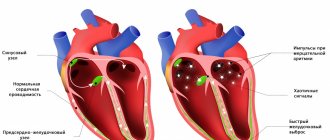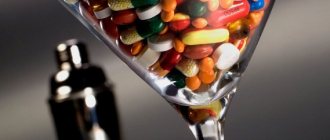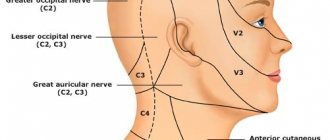Indications
◊ Recommendations of the Russian Ministry of Health
F32 Depressive episode
F33 Recurrent depressive disorder
F40.0 Agoraphobia
F41.0 Panic disorder (episodic paroxysmal anxiety)
◊ FDA recommendations
- Major depressive disorder (adults and children over 12 years of age)
- GTR
◊ Recommendations from UK Medicines and Healthcare Products Regulatory Agency
- Major depressive episode
- Panic disorder with/without agoraphobia
- Social phobia
- GTR
- OCD
◊ Using Off-label
- Vasomotor symptoms during menopause
- Insomnia
- Dysmorphophobia
- Bulimia [5].
Mechanism of action and pharmacokinetics
Escitalopram is the S-isomer of citalopram. Selectively inhibits the reuptake of serotonin, increasing the concentration of this neurotransmitter in the synaptic cleft. Escitalopram, like other antidepressants from the SSRI group, practically does not bind to dopamine (D1 and D2) receptors, α-adrenergic and m-cholinergic receptors, as well as benzodiazepine and opioid receptors [4]. Long-term use of escitalopram leads to desensitization of somatodendritic 5-HT1A and terminal autoreceptors.
- Bioavailability – 80%.
- Half-life 27-32 hours
- Stable concentration in the blood is maintained for one week
- Metabolized by CYP3A4, CYP2C19; inhibits CYP2D6
Pharmacological properties of the drug Escitalopram
Escitalopram is an antidepressant, a selective inhibitor of neuronal serotonin reuptake. It is the S-stereoisomer of racemic citalopram. The mechanism of action is associated with potentiation of serotonergic activity in the central nervous system, which is caused by inhibition of the reverse neuronal uptake of serotonin (5-HT). The effect on neuronal reuptake of norepinephrine and dopamine is minimal. Escitalopram is at least 100 times more potent than the R-enantiomer in inhibiting serotonin reuptake. Escitalopram has no or very low affinity for 5-HT1 and other receptors, including α- and β-adrenergic, dopaminergic (D1), histamine (H1), muscarinic (M1) and benzodiazepine receptors. Escitalopram also does not bind or has a low degree of binding to various membrane ion channels, including Na+, K+, Cl- and Ca2+ channels. The pharmacokinetics of escitalopram is linear and proportionally dependent on the dose in the range of 10–30 mg/day. After oral administration, the maximum plasma concentration is reached within 5 hours. The absorption of escitalopram does not depend on simultaneous food intake. Bioavailability (for citalopram) is about 80%. The volume of distribution (for citalopram) is 12 l/kg body weight. Approximately 56% of escitalopram is bound to plasma proteins. When taken once a day, the equilibrium state is achieved on average after 1 week. Biotransformation of escitalopram occurs primarily in the liver. The main metabolites of escitalopram - S-demethylcitalopram and S-didemethylcitalopram - do not have significant pharmacological activity. The half-life is 27–32 hours. Oral clearance is 600 ml/min, renal clearance is 7% of this amount. About 8% is excreted in the urine as escitalopram and 10% as S-demethylcitalopram.
Treatment regimen
◊ Dosage and dose selection
- Optimal dose for treating depression, OCD and GAD: 10-20 mg/day
- Start with 10 mg/day, increase to 20 mg if necessary
- Take once daily, morning or evening
- 10 mg escitalopram is comparable to 40 mg citalopram, but without side effects
- A dose of 30-40 mg is suitable for some patients [1]
- To relieve vasomotor symptoms during menopause, 10 mg/day is sufficient, but if ineffective within 4 weeks, the dose may be increased to 20 mg/day
- If anxiety, insomnia, agitation, or akathisia occur at the beginning of treatment or after interruption of treatment, the possibility of bipolar disorder should be considered and switched to a mood stabilizer or an atypical antipsychotic
◊ How quickly it works
- Begins to act after 2-4 weeks
- If there is no effect after 6-8 weeks, you need to increase the dose or switch to another drug
- To prevent relapse, it can be taken for many years.
◊ Expected result
- Complete remission.
- After the symptoms of depression disappear, you should continue taking it for 1 year if this was the treatment of the first episode. If this is to treat a recurrent episode, treatment can be extended indefinitely.
- Use in the treatment of anxiety and chronic pain may be indefinite.
◊ If it doesn't work
- Change the dose, switch to another medicine or add an auxiliary drug;
- Connect psychotherapy;
- Review the diagnosis by identifying comorbid conditions;
- In patients with undiagnosed bipolar affective disorder, the effectiveness of treatment may be low, in which case it is necessary to switch to a mood stabilizer [1].
- In the acute phase of severe depressive disorder, which is accompanied by psychotic or catatonic symptoms, as well as in patients with current suicidal ideation, electroconvulsive therapy should be considered [7].
◊ How to stop taking it
It is usually not necessary to reduce gradually, but to be sure to avoid withdrawal symptoms, you can reduce it gradually. Gradual reduction scheme: dose reduced by 50% - 3 days, again reduced by 50% - 3 days, complete cessation. If withdrawal symptoms appear, increase the dose, wait for withdrawal symptoms to subside, and continue decreasing [1].
◊ Treatment combinations
- For insomnia: trazadone
- For fatigue, drowsiness, loss of concentration: modafinil [3].
- Combinations with other antidepressants may activate bipolar disorder and suicidal ideation
- For bipolar depression, psychotic depression, treatment-resistant depression, treatment-resistant anxiety disorder: mood stabilizers, atypical antipsychotics
- For anxiety disorder: gabapentin, tiagabine
Antidepressants
Should I take antidepressants for severe depression? Many people believe that such drugs are addictive. If previously drugs that could cause addiction and drug dependence were used in psychotherapy, today new generation drugs are used that affect the human body and psyche more gently and sparingly.
Among the reasons for mistrust in the use of antidepressants for depression is the fact that if the course of treatment is interrupted, a person may feel worse. If withdrawal symptoms occur, this indicates incorrect discontinuation of the prescribed drug. You should not perceive this reaction of the body as dependence on pills.
If you stop the artificial synthesis of brain neurotransmitters, their quantity in the human body will drop sharply. Patients feel that their depression or anxiety disorder is returning as anxiety increases. Any changes in your condition should be reported to your doctor. The specialist knows how to smoothly discontinue the prescribed medication. In combination with psychotherapy, pharmacotherapy works well, giving long-term results.
There are several groups of medications for anxiety and depression.
Tricyclic
The first group includes medications that have a three-cyclic structure; they are not sedatives and prevent the immediate breakdown of neurotransmitters (serotonin and norepinephrine). They do not disappear from the nerve endings, their synthesis increases, as does the amount of serotonin. These medications have a number of contraindications; they are not recommended for people who have kidney and liver diseases, glaucoma, atherosclerosis, or use of narcotic substances.
Monoamine oxidase inhibitors (MAOIs)
MAOIs are monoamine neurotransmitters that regulate our emotions, as well as a number of processes in the brain: attention, cognitive functions, memory, arousal. Due to the inhibition of leasing, the amount of monoamines increases and their accumulation in nerve endings. Some groups of these drugs are contraindicated for pregnant women and people with work that requires concentration, as well as for hypertensive patients.
Selective serotonin uptake inhibitors (SSRIs)
The third group of drugs for the treatment of depression includes selective serotonin uptake inhibitors.
Medicines are prescribed to replenish “happiness hormones”. Do not think that this happens quickly; the process of restoration of neurotransmitters is gradual. SSRIs have one important advantage - when the drugs are abruptly stopped, there is no withdrawal syndrome. Contraindications to their use include diseases of the genitourinary system, as well as alcoholism and drug addiction. If a person has developed alcoholism due to depression, he should not take antidepressants, since alcohol increases the side effects of the medication for depression. Symptoms of the disorder may increase significantly and the condition may worsen. Quite often, psychological reasons cause the development of alcohol dependence; the risk of depression in alcoholics is several times higher than in healthy people. The first group of anti-depression drugs is especially dangerous to combine with ethanol, as this leads to a sharp increase in blood pressure.
Which antidepressant is best for anxiety and depression? Your doctor will answer this question; the choice of medications should always take into account the individual characteristics of the patient’s body.
Do you want to know about the cost of services?
8 call our specialist
Special patient groups
◊ Patients with kidney problems
Use caution if the patient has severe kidney disease [1].
◊ Patients with liver disease
The recommended dose is 10 mg/day [1].
◊ Patients with heart disease
There are no systematic data on the use of escitalopram in people with pathology of the cardiovascular system. Supposedly safe. Useful in recovery after a heart attack [1].
◊ Elderly patients
For elderly patients, a dose of 10 mg is recommended [1].
◊ Children and teenagers
- Recommended for the treatment of depression aged 12-17 years
- It is necessary to regularly and personally check the patient's condition, especially in the first weeks of treatment.
- Use with caution due to the risk of undiagnosed bipolar disorder and suicidality.
- Inform adults about the risks.
◊ Pregnant women
- There have been no adequate studies in pregnant women [1].
- Not recommended for pregnant women, especially in the first trimester
- All risks should be weighed and compared
- Bleeding can be expected during childbirth
◊ Breastfeeding
- The medicine passes into breast milk.
- If the infant shows signs of irritation or sedation, discontinue feeding or escitalopram
- However, treatment after childbirth may be necessary, so the risks should be weighed.
Escitalopram
Use during pregnancy and breastfeeding
Contraindicated for use during pregnancy and lactation (breastfeeding).
Use for liver dysfunction
Should be used with caution in case of liver cirrhosis.
Use for renal impairment
It should be used with caution in patients with renal failure (creatinine clearance less than 30 ml/min).
Use in children
Contraindicated in children and adolescents under 15 years of age.
Use in elderly patients
Should be used with caution in elderly patients.
special instructions
Use with caution in patients with renal failure (creatinine clearance less than 30 ml/min), hypomania, mania, pharmacologically uncontrolled epilepsy, depression with suicidal attempts, diabetes mellitus, elderly patients, cirrhosis of the liver, a tendency to bleeding, simultaneously with taking medications that reduce the threshold of convulsive readiness, causing hyponatremia, with ethanol, with drugs metabolized with the participation of isoenzymes of the CYP2C19 system.
Escitalopram should be prescribed only after 2 weeks. after discontinuation of irreversible MAO inhibitors and 24 hours after discontinuation of therapy with a reversible MAO inhibitor. Non-selective MAO inhibitors can be prescribed no earlier than 7 days after discontinuation of escitalopram.
Some patients with panic disorder may experience increased anxiety at the beginning of treatment with escitalopram, which usually disappears over the next 2 weeks. treatment. To reduce the likelihood of anxiety, low initial doses are recommended.
Escitalopram should be discontinued if epileptic seizures develop or become more frequent in pharmacologically uncontrolled epilepsy.
If a manic state develops, escitalopram should be discontinued.
Escitalopram can increase the concentration of glucose in the blood in diabetes mellitus, which may require dose adjustment of hypoglycemic drugs.
Clinical experience with escitalopram indicates a possible increase in the risk of suicide attempts in the first weeks of therapy, and therefore it is very important to carefully monitor patients during this period.
Hyponatremia associated with decreased ADH secretion occurs rarely with escitalopram and usually disappears when it is discontinued.
If serotonin syndrome develops, escitalopram should be immediately discontinued and symptomatic treatment prescribed.
Impact on the ability to drive vehicles and operate machinery
During the treatment period, patients should avoid driving vehicles and other activities that require high concentration and speed of psychomotor reactions.
Side effects and other risks
◊ Mechanism of side effects
Side effects are caused by an increase in serotonin. Most side effects occur immediately after starting treatment and go away over time.
◊ Side effects
- Gastroenterological (reduced appetite, nausea, diarrhea, constipation)
- Insomnia, sedation, agitation, tremor
- Sweating
- Urinary dysfunction
- Dry mouth
- Dangerous side effects: seizures, mania, suicidal ideation
- Weight gain: very rare
- Sedation: very rare
- Sexual dysfunction: yes
◊ What to do about side effects
- Wait
- Switch to another antidepressant [1].
◊ Long-term use
Safely
◊Addiction
No.
◊ Overdose
- There are very few reports of overdose.
- Very rare cases of fatal overdoses.
- Vomiting, sedation, cardiac arrhythmia, dizziness, tremor.
Escitalopram overdose, symptoms and treatment
Cases of overdose have been described with taking escitalopram at a dose of up to 600 mg; no symptoms of intoxication were noted. An overdose of racemic citalopram (at a dose of up to 2 g) did not lead to death. Lethal outcome is possible with a more significant overdose, mainly when combined with other psychotropic drugs or alcohol. In case of an overdose of citalopram, dizziness, sweating, nausea, vomiting, tremor, drowsiness, sinus tachycardia, and convulsions are most often observed. Less common are amnesia, confusion, coma, hyperventilation, cyanosis, rhabdomyolysis, and ECG changes (including prolongation of the QT and ventricular arrhythmias). Ensure patency of the upper respiratory tract to maintain adequate ventilation and oxygenation, monitor blood pressure, ECG and external respiration. There is no specific antidote; Treatment is supportive and symptomatic. Due to the large volume of distribution of escitalopram, forced diuresis, dialysis, hemoperfusion and exchange transfusion are ineffective.
List of pharmacies where you can buy Escitalopram:
- Moscow
- Saint Petersburg
Expert advice
- The best antidepressant in terms of tolerability
- Lowest sexual impact compared to other SSRIs
- Lack of response to escitalopram in elderly patients may indicate Alzheimer's disease
- In postmenopausal women, escitalopram works better in combination with estrogen [1]
- Escitalopram and fluoxetine show similar effects in the treatment of depression. The only difference noted is that escitalopram significantly improves microinflammation in the patient’s body [6].








